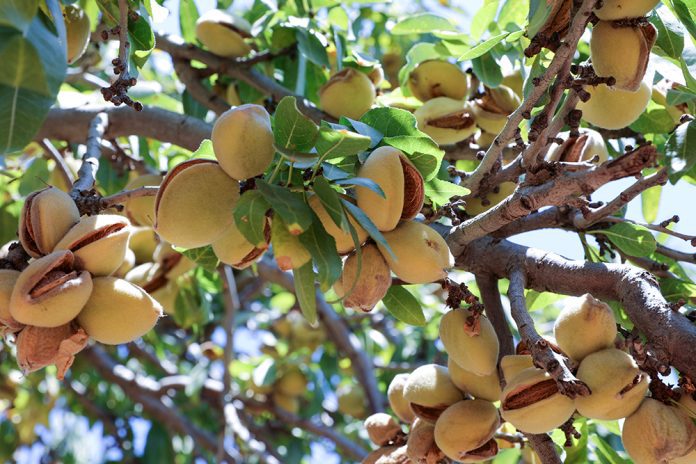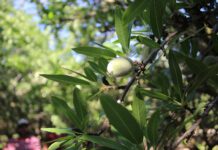Navel orangeworm (NOW) is one of the top pests affecting almond production in California. NOW damage decreases almond yield, quality of meats and the price a grower receives. Furthermore, NOW damage is linked to aflatoxin, a known human carcinogen. Aflatoxin contamination is highly regulated in key markets, such as the European Union, and can lead to rejected almond shipments. Ultimately, increased rejection rates could decrease global demand for U.S. almonds, making it imperative for growers to reduce NOW damage in their orchards.
The primary tools available to growers to combat NOW include monitoring NOW populations, winter sanitation (removing and destroying mummy nuts left from the previous year’s harvest), chemical pesticide sprays and timely harvest. The University of California Integrated Pest Management (IPM) Guidelines Publication 3431 provides a practical guide to the available tools. When used in combination, an IPM protocol can reduce the incidence of NOW damage and the share of harvested meats rejected by the processor, leading to increased yields and potentially price premiums for quality. In this article, we outline some economic considerations for growers as they make NOW management decisions for their almond orchards.
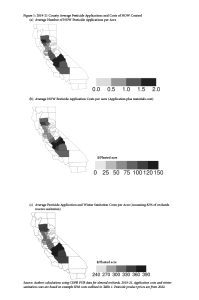
NOW Management Costs as a Percentage of Annual Operating Expenses
To illustrate the costs associated with an NOW pest management program, we referred to the 2019 UC Davis Cost Studies for conventional almond production in California. The representative farms in each of these studies use an NOW pest management program consisting of winter sanitation in January and two chemical pesticide applications after hull split. Pesticides, equipment and labor costs have changed substantially since 2019, so rather than reporting dollar values of costs, we focus on NOW management costs as a percentage share of annual operating costs and present the estimates in Table 1. Across all three regions, NOW management costs are a substantial share of annual operating costs, ranging from 9.3% in the southern San Joaquin Valley to 14.1% in the northern San Joaquin Valley. Differing percentages across regions are due to differing NOW management practices as well as regional variation in other orchard operating costs.

NOW Management Costs by California County
Pesticide sprays targeting NOW are a meaningful share of orchard operating costs. To obtain a more accurate picture of spraying costs in recent years, we used data from the California Department of Pesticide Regulation (CDPR) Pesticide Use Reporting (PUR) database from 2019-21. Our analysis focuses on pesticide products specifically targeting NOW in almond orchards. Figure 1 (see page 12) shows results of this analysis. On average, almond growers use 1.4 pesticide applications per acre targeting NOW (Figure 1a). Using updated 2022 pesticide product, labor and fuel prices, we estimate on average, growers spend $93 per acre applying pesticides targeting NOW (Figure 1b). In both Figures 1a and 1b, it is clear there is regional variation in NOW pesticide applications and corresponding costs.
Growers in Fresno and Madera counties spray for NOW more frequently and spend the most on spraying for NOW. Figure 1c shows costs per acre including winter sanitation. We assume 82% of almond orchards receive winter sanitation and that winter sanitation costs are $306/acre as outlined in Table 2. The statewide average cost of pesticides plus winter sanitation is $344 per acre (Figure 1c). Using 1.37 million bearing acres of almonds, this means California growers on average spent over $471 million dollars on NOW management costs using 2022 prices, not including trap monitoring or mating disruption costs. This amounts to roughly 9% of the 2021/22 total almond value of $5 billion. These costs are substantial, especially in years with relatively low almond prices. However, when compared to losses associated with NOW damage, the economic benefits of the NOW IPM program outweigh the costs in most situations.
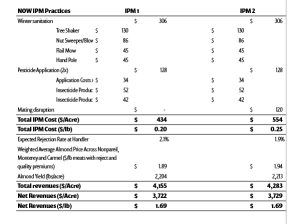
Comparing Economic Benefits of NOW IPM Programs
Table 2 outlines the costs and associated returns comparing two NOW IPM programs on a per acre basis (monitoring NOW populations is assumed to occur in both IPM programs, but we do not incorporate these costs into the analysis.) In both IPM programs, the grower uses winter sanitation and applies two pesticides. In IPM 2, the grower also uses season-long mating disruption for NOW with in-orchard dispensers, which has been increasing in popularity over the last few years (see UC IPM Guidelines Publication 3431 for a list of mating disruption products.) In terms of the cost per pound of almond meats produced, IPM 1 and IPM 2 cost $0.20/lb and $0.25/lb, respectively. For both IPM programs, the net returns per pound of almond meats produced are $1.69. Thinking of this another way, the grower could spend up to $1.69/lb on all other inputs (fertilizer, fungicides, etc.) and still break even with respect to annual operating costs. Thus, NOW IPM is costly but is likely essential for making almonds profitable due to the potential impacts on yield, quality and price.
Assessing the differences between the net economic benefits between IPM 1 and IPM 2 illustrates a framework growers can follow if they are considering adopting mating disruption or changing another part of their IPM program. IPM 2 is more costly per acre and per pound of meats produced due to the added cost of mating disruption (about $120/acre). However, in this example, adding mating disruption decreases the grower’s expected share of meats rejected at the handler from 2.1% to 1.9%. The lower rejection rate at the handler for IPM 2 also means price premiums and a higher yield of undamaged nuts. When comparing the net revenues per acre, IPM 2 exceeds that of IPM 1 by $7/acre. Thus, a grower choosing between these two programs would find it most profitable to choose to incorporate mating disruption into their NOW management program.
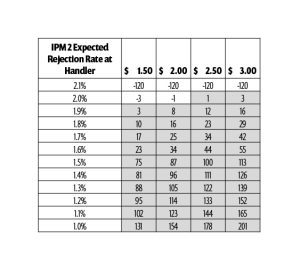
It is important to note that mating disruption may not decrease damage rates in all orchards. For example, mating disruption is generally less effective in small orchards (<40 acres) and long, narrow orchards due to populations of NOW in neighboring orchards (Wilson et al. 2020). However, a field study by Haviland et al. (2021) showed the use of mating disruption decreased kernel damage by 35% to 53%, so in some cases it can have a large impact on grower revenues.
Tables 3 and 4 show breakeven rates for comparing IPM programs 1 and 2 at various almond prices, costs of mating disruption and IPM 2 rejection rates. These tables show the net benefit of switching from IPM 1 (no mating disruption) to IPM 2 (mating disruption). Any shaded squares indicate that for the corresponding rejection rate at the handler, almond price and mating disruption cost scenario, switching to IPM 2 results in economic benefits.
Table 3 shows at a mating disruption cost of $120/acre, even modest decreases in expected rejection rates mean mating disruption is economically beneficial in some situations. For example, moving from 2.1% rejection rate with IPM 1 to a 1.9% rejection rate with IPM 2 results in small economic benefits when almond prices are low and modest benefits when prices are high. However, with the use of mating disruption, rejection rates as low as 1% are feasible (Haviland et al. 2021), and the benefits are substantial, ranging from $131 to $201 per acre, depending on the almond price level.
Similarly, Table 4 shows that for a cost of mating disruption of $100/acre, moving from rejection rates of 2.1% to 2.0% leads to a net economic benefit when the Nonpareil price is $2/lb. For the most expensive mating disruption scenario ($130/acre), it is only necessary for mating disruption to decrease the expected rejection rate at the handler to 1.8% for mating disruption to make economic sense.
Other Economic Considerations for NOW IPM
As growers make their IPM decisions, it is important to address the many uncertainties inherent in almond production. A grower who spends over $300/acre on winter sanitation only to have a frost occur during bloom that destroys the almond crop for the year will not be pleased with their winter sanitation effort in hindsight. To alleviate this risk, growers can consider enrolling in catastrophic crop insurance offered through USDA Risk Management Agency (RMA). This policy will reimburse growers for yield losses below 50% of the average yield for an orchard and only requires the grower to pay an administrative fee of $655 per crop per county (all premiums are subsidized by USDA for catastrophic coverage.) Such a policy is inexpensive and can help growers recoup input costs that occurred prior to the catastrophic weather event. Buy-up coverage is also available if the grower wishes to insure a higher portion of their average yield, but buy-up coverage is more expensive. Most of California’s almond acreage is already insured through federal crop insurance, but growers who are not currently insured can get information from a certified crop insurance agent. USDA-RMA provides an online crop insurance agent locator.
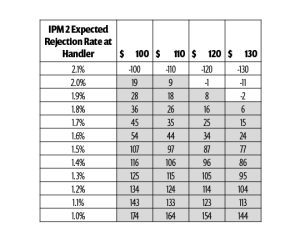
Varying pest pressure, weather conditions, and yield targets mean there is no “one-size-fits-all” strategy for profitable NOW IPM decisions. The same grower may even have different IPM programs across different almond orchards, depending on the characteristics of that year and orchard. It is important for growers to think critically about their NOW IPM program, remembering that maximizing long-term profitability of their almond orchard may not involve minimizing costs of NOW management.
References
2019 Cost and Returns Studies for Almond Production in Sacramento Valley, San Joaquin Valley North and San Joaquin Valley South: https://coststudies.ucdavis.edu/en/current/commodity/almonds/
Haviland, David R., et al. “Management of navel orangeworm (Lepidoptera: Pyralidae) using four commercial mating disruption systems in California almonds.” Journal of Economic Entomology 114.1 (2021): 238-247.
USDA RMA Crop Insurance Locator: https://public-rma.fpac.usda.gov/apps/AgentLocator/#/
Wilson, H. et al. “Biology and management of navel orangeworm (Lepidoptera: Pyralidae) in California.” Journal of Integrated Pest Management 11.1 (2020): 25.
Zalom, F. et al. (2019) UC IPM Almond Pest Management Guidelines: Navel Orangeworm. UC ANR Publication 3341: https://ipm.ucanr.edu/agriculture/almond/navel-orangeworm/


